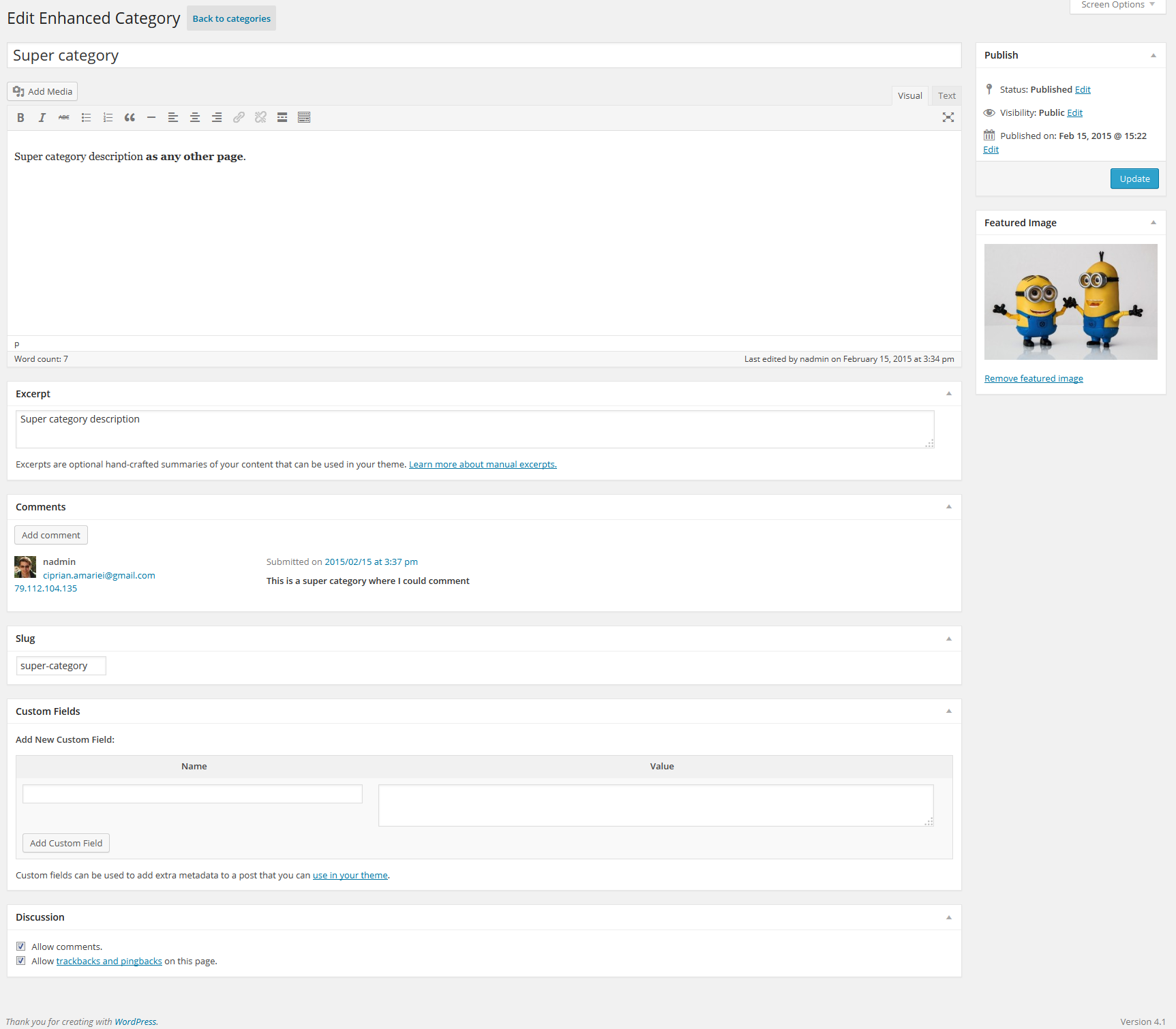
Enhanced Category Pages Plugin
Create custom enhanced pages for categories and any taxonomy term and manage them as a custom post.
NEW Version 2.0.0 brings a great new feature: with some magic, if your theme displays category/term description, then it would be automatically enhanced.
Are you ready for more? You can customize the template by creating a content-ecp.php file in your theme of choice.
Enhanced Category Pages allows you to create custom category and term pages by managing them using a special custom post type.
Premium code quality ensured by Codacy static analysis: grade A.
Features
- NEW Visual Composer compatible – you can now edit the category using Visual Composer
- NEW Genesis Framework compatible
- WooCommerce compatible – product categories can be enhanced now
- Easy to use for everyone: users, designers, developers
- Automatically show enhanced category/term content
- Customize enhanced category/term content by creating a
content-ecp.phpfile in your theme of choice - Traverse categories using setup_ec_data that allows now category id as parameter
- Enhance any taxonomy: edit any taxonomy term as a custom post
- Edit category as a custom post – Enhanced Category
- Automatically generates Enhanced Category post type for each category
- Transparent synchronization of Enhanced Category and it’s corresponding category
- Add any features available to WordPress custom posts
- Easy Enhanced Category display on category template using
<?php $GLOBALS['enhanced_category']->setup_ec_data(); ?>(see install section) - Internationalization ready
Future Features
- customize Enhanced Category custom post type capabilities via plugin options
- manual selection on enhanced categories
Installation
- Download plugin archive.
- Upload and uncompress it in “/wp-content/plugins/” directory.
- Activate the plugin through the “Plugins” menu in WordPress.
- Use “Enhanced Edit” link to edit the page of the respective category
- Category/term description display is automatically enhanced with your content.
- Optional: create
content-ecp.phpin your theme folder to customize the display.
Advanced usage options
Create
content-ecp.phpin your theme folder to customize the display of the enhanced content. The custom post associated with category/term is set up, so all display functions for posts are usable.<?php global $enhanced_category; // if not previously set up, then let setup_ec_data get the current query term/category if (empty($categoryId)) { $categoryId = null; } // get enhanced category post and set it up as global current post $enhanced_category->setup_ec_data($categoryId); ?> <!-- enchanced category page (ECP) content --> <article id="post-<?php the_ID(); ?>" <?php post_class(); ?>> <div class="post-thumbnail"> <?php the_post_thumbnail(); ?> </div> <div class="entry-content"> <?php the_content(); ?> </div><!-- .entry-content --> <?php edit_post_link( __( 'Edit'), '<footer class="entry-footer"><span class="edit-link">', '</span></footer><!-- .entry-footer -->' ); ?> </article><!-- #post-## -->Display category/term page. Edit category/taxonomy template to show the content of the “Enhanced Category” (feel free to adjust to your needs):
//in category.php or taxonomy.php or any other place your theme displays the category/term content <?php global $enhanced_category; //get enhanced category post and set it up as global current post $enhanced_category->setup_ec_data(); ?> <!-- enhanced category content --> <?php the_post_thumbnail("medium"); ?> <?php get_template_part( 'content', 'page' ); ?> <!-- custom fields --> <?php get_post_custom(); ?> <?php // If comments are open or we have at least one comment, load up the comment template if ( comments_open() || get_comments_number() ) : comments_template(); endif; ?>Display a list of categories:
//$categories is presumed to be an already fetched array of categories/terms foreach($categories as $category) { $GLOBALS['enhanced_category']->setup_ec_data($category->term_id); the_post_thumbnail('thumbnail'); }
Screenshots
FAQ
How does magic happen?
We use the category_description or get_the_archive_description filters in order to replace the plain content with the enhanced one.
How can I customize the output?
content-ecp.phpandcontent-page.phppartial templates are looked for (in that order) and the first found is loaded.
What custom post type is created?
Enhanced Category (safe name: enhancedcategory) custom post type is created and a post is generated automatically for each category/term.
What happens if I edit the category fields?
Enhanced Category Post (ECP) is synchronized in both directions with it’s corresponding category i.e. category name – ECP title, category slug – ECP slug, category description – ECP excerpt.
What happens with *Enhanced Category* posts when the plugin is uninstalled?
Enhanced Category posts are deleted when the plugin is deleted using the WordPress plugin management page. Note: nothing is deleted when the plugin deactivated.
Can I use it to list any categories/terms?
Yes, you can pass the category/term id to setup_ec_data method like this ($categories is presumed to be an already fetched array of categories/terms):
foreach($categories as $category) { $GLOBALS['enhanced_category']->setup_ec_data($category->term_id); the_post_thumbnail('thumbnail'); } Why do I get a blank screen after installing the plugin?
Enhanced Category Post (ECP) requires at least PHP 5.3 running on your server. Contact your hosting to update the PHP version.
Changelog
0.1
- Initial release.
0.2
- Make php 5.3 compatible.
1.0
- Enhance any taxonomy
1.0.1
- bug fixing
1.0.2
- setup_ec_data allows now category id as parameter
2.0.0
- automatically show the enhanced content using
category_descriptionorget_the_archive_descriptionfilters - customize the display of content with
content-ecp.phptheme partial template
2.0.1
- bug-fix – prevent undesired PHP warning on category_description filter
- check and update 4.3.1 compatibility
2.1.0
- WooCommerce product category can be enhanced now
2.1.1
- Improve code quality
2.1.2
- Add WordPress 4.4 compatibility
2.1.3
- Bug fix: correctly handle categories with apostrophes
2.2.0
- All in One SEO Pack plugin compatibility added
2.2.1
- Minor bug fix: prevent PHP notice
2.3.0
- Add Visual Composer compatibility
- Add Genesis Framework compatibility
- Bug fix: Woocommerce shop page does not display the description of the first product anymore
- Bug fix: archive pages were showing the content of the first item



